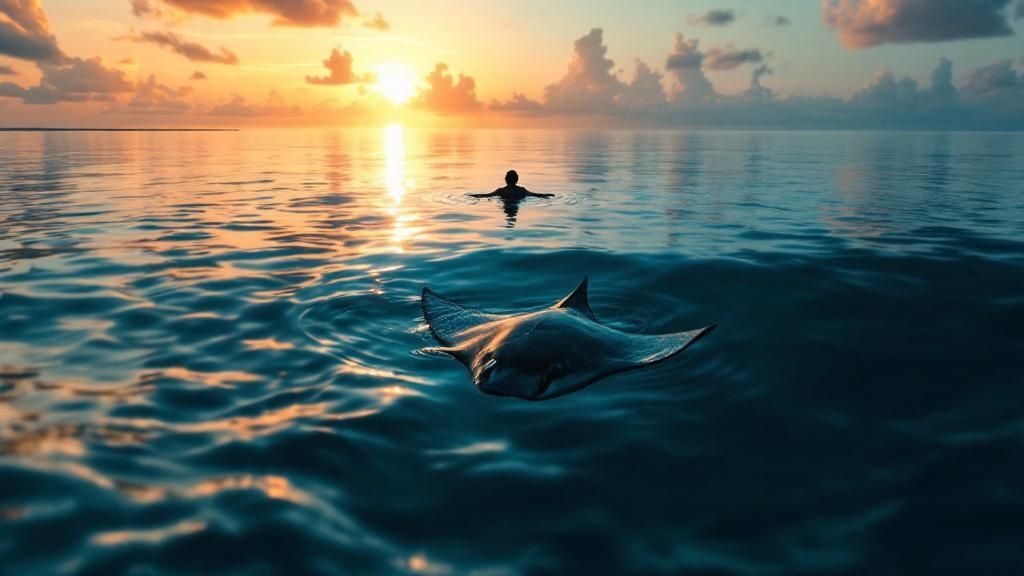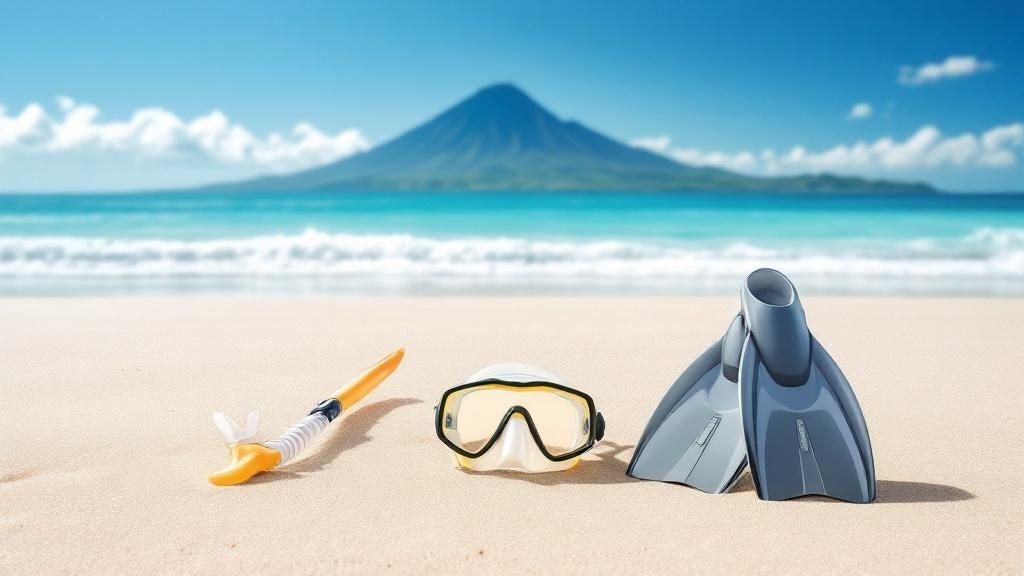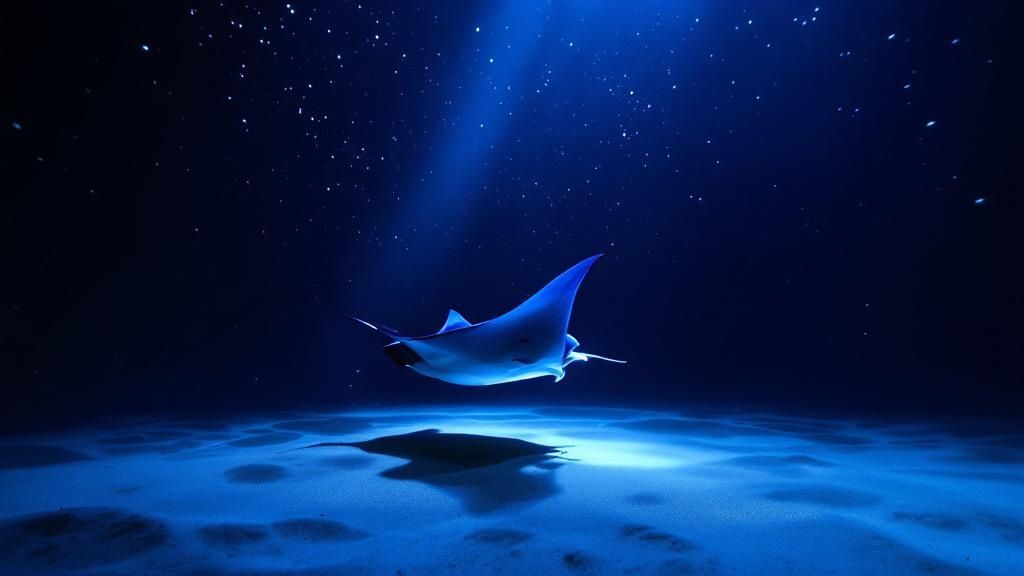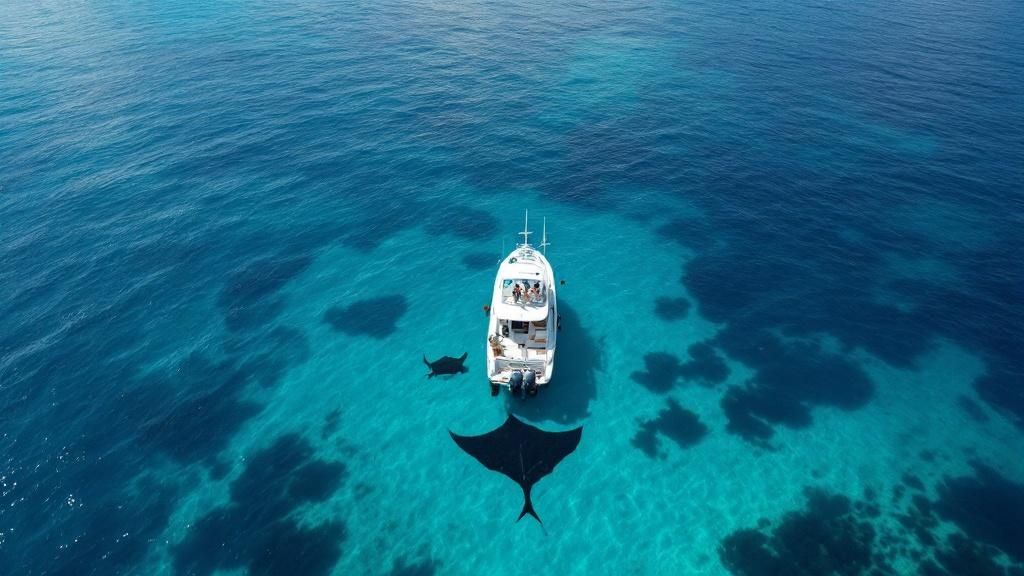Your Manta Ray Snorkel Big Island Adventure Guide
- Byron
- Aug 6
- 12 min read
Picture this: you're floating weightlessly in the warm, dark Pacific Ocean. Below you, giant, graceful manta rays soar through the water, their white bellies glowing under bright lights. They glide so close you can see every detail. This isn't a nature documentary—it's the very real and accessible magic of a manta ray snorkel on the Big Island.
If you're looking for a truly unforgettable adventure, you've found it. Let's get you ready for one of the most incredible wildlife encounters on the planet.
Why Kona is the Manta Ray Capital of the World
When it comes to seeing manta rays, the Kona Coast isn't just a great spot; it's the spot. There's a reason people travel from all over the globe for this experience. The conditions are perfect, and a healthy, reliable population of these gentle giants calls this coastline home.
Highly-rated local operators like Manta Ray Night Snorkel Hawaii have turned this natural phenomenon into a safe and breathtaking adventure. You just have to look at the reviews for Manta Ray Night Snorkel Hawaii to see what a powerful experience this is for so many visitors.
This guide is your complete walkthrough for one of Hawaii's most awe-inspiring activities. We'll cover everything from picking the best tour to what you can expect in the water, setting you up for an adventure you’ll be talking about for years to come.
The Science Behind the Spectacle
So, what makes Kona the world's best place to snorkel with manta rays? It's a fantastic mix of biology and geology. The secret lies in a thriving local population of more than 450 identified individuals and their favorite food: plankton.

The island's volcanic coast creates nutrient-rich waters that attract massive amounts of plankton. Decades ago, a hotel started shining lights into the water, which attracted the plankton, and the mantas soon followed. Today, tour operators have perfected this technique. They shine powerful lights into the water at well-known sites like "Manta Village," essentially creating a concentrated plankton buffet that draws the rays in for a nightly feast.
The result is an incredible 85% to 90% sighting success rate, making this one of the most reliable wildlife encounters you can book. If you're curious, you can learn more about Kona's unique manta environment and dive statistics to see what makes it a world-class destination.
This isn't just a tour; it’s a natural spectacle. You're witnessing a unique feeding behavior that has made the Big Island famous among marine life enthusiasts worldwide.
Ready to make it happen? Let's dive into the details.
How to Choose the Right Manta Ray Snorkel Tour

Picking the right tour operator is easily the most important decision you'll make for your manta ray snorkel on the Big Island. It's the difference between a once-in-a-lifetime memory and just another boat trip.
A truly great tour company does more than just get you in the water. They live and breathe safety, prioritize your comfort, and, most importantly, show deep respect for the mantas themselves.
I've seen it all out there, and trust me, not all tours are created equal. The best ones are run by people who are passionate about the ocean, not just about turning a profit. This usually translates to smaller groups, better gear, and a much more personal experience.
When you're starting your search, it helps to see what the top-tier operators are doing. A great example is Manta Ray Night Snorkel Hawaii. Browsing their site gives you a solid benchmark for what a safe, professional, and ethical tour should look like.
Key Factors for Choosing an Operator
First things first: group size. This is huge. A boat packed with dozens of people creates a chaotic, crowded experience in the water. You end up bumping into other snorkelers instead of focusing on the mantas.
Look for companies that deliberately keep their groups small. It’s a completely different vibe—more relaxed, more personal, and far safer. Your guides can actually keep an eye on everyone and offer help when needed.
Next, look at the crew's experience. Are the guides just summer hires, or are they seasoned marine naturalists? You want the latter. Passionate guides don’t just point and say, "There's a manta." They tell you their names (yes, they have names!), share incredible facts about their behavior, and make the entire trip feel like an adventure with a purpose.
Finally, and this is non-negotiable, check their commitment to responsible tourism. The best companies are deeply invested in protecting the animals that provide their livelihood.
Insider Tip: Look for operators who are "Manta Ray Green List" certified or actively involved in local conservation. This is your guarantee that they follow the strict "look, don't touch" rules that keep the mantas safe and their habitat healthy for generations to come.
Comparing Tour Operator Features
It can feel like a lot to juggle when you're comparing different companies online. To make it easier, I’ve put together a quick checklist of what really matters. This is the stuff you should be asking about before you hand over your credit card.
Tour Operator Checklist: What to Look For
Here’s a quick reference guide to help you vet potential tour operators and make a confident choice.
Feature | Why It Matters | What to Ask |
|---|---|---|
Small Group Size | Fewer people means a calmer, more personal encounter. It's safer and gives you a better view. | "What's the absolute maximum number of guests you take on a single tour?" |
Experienced Guides | You're trusting them with your safety in the dark ocean. Lifeguard certification is a big plus. | "Are your guides lifeguard certified? How long have they been leading manta tours?" |
'Manta Green List' Principles | This shows they're committed to the mantas' well-being, not just making money. | "How does your company follow responsible manta interaction guidelines?" |
High-Quality Gear | A leaky mask or a thin, worn-out wetsuit can ruin your night. Good gear is essential for comfort. | "What kind of gear do you provide? Are wetsuits included in the price?" |
Taking a few extra minutes to choose wisely ensures your adventure is both mind-blowing and mindful of the incredible marine life you've come all this way to see.
If you want to see who consistently checks all these boxes, take a look at our detailed guide on the best manta ray snorkel tours on the Big Island. We've done the homework for you.
Ready to book an unforgettable—and ethical—adventure?
Getting Ready for Your Manta Ray Night Snorkel

A little bit of prep work can elevate your manta ray snorkel on the Big Island from just a cool activity to a truly unforgettable life experience. When you know what to expect and what to bring, you can relax and just soak in the magic.
The best tour companies, like Manta Ray Night Snorkel Hawaii, take care of all the heavy lifting, but packing a few personal items will make a world of difference.
What to Wear and Pack
Let's talk about the essentials. Even though Kona's waters feel amazing, you'll be floating around for roughly 45 minutes as the sun goes down and night sets in. It can get chilly.
My advice? When your guide offers you a wetsuit, always say yes! It does more than just keep you warm; the extra buoyancy makes floating effortless, so you can focus on the show below.
Here’s a quick checklist of what I always bring:
Towel & Dry Clothes: Absolutely essential for the boat ride home. You'd be surprised how a cool breeze feels after you get out of the water, even in paradise.
Reef-Safe Sunscreen: If you're on a sunset tour, slather it on before you even get on the boat.
Reusable Water Bottle: Hydration is key, on and off the water.
A Light Jacket: Trust me on this one. You’ll be so glad you have it for the breezy ride back to the harbor.
Getting in the Right Headspace
Physical prep is one thing, but getting mentally ready is just as crucial, especially if the idea of being in the ocean after dark gives you a few butterflies. That’s completely normal! The key is to trust your guides, your gear, and the process.
You won't be swimming around on your own. You'll be holding onto a big, stable, brightly lit flotation board the whole time. You don’t need to be a strong swimmer—you just need to be comfortable floating and looking down. The guides are right there in the water with you, keeping an eye on everyone and making sure the whole operation runs smoothly and safely.
It also helps to manage expectations. Remember, these are wild animals. While Kona has an incredible 90% sighting success rate, the mantas are on their own schedule. Go with an open mind and a sense of wonder, and you'll have an amazing time no matter what.
Once you understand the safety protocols and put your trust in the crew, you can let go of any anxiety. This lets you be fully present for what is genuinely one of the most awe-inspiring wildlife encounters on Earth.
Ready to start planning your own adventure? You can see what's available right here.
What Makes the Manta Rays Show Up? A Look at the Science and Conservation
Ever wonder what makes the manta ray snorkel on the Big Island so consistently magical? It’s not just luck. It's a clever and respectful setup that taps directly into a manta ray's most basic instinct: the need to eat.

Here's how it works. Reputable tour operators use powerful (and completely safe) underwater lights. These bright beams attract a massive cloud of phytoplankton and zooplankton—the tiny organisms that make up the mantas' primary diet.
For the rays, this is like an all-you-can-eat buffet that appears like clockwork every night. They don't have to hunt for their food; they just glide effortlessly through the light beams with their cavernous mouths open, filtering out a feast. This behavior is what creates the famous "manta dance," where they perform graceful barrel rolls and loops to spend as much time as possible in the food-rich light.
More Than a Tour: You’re Part of a Citizen Science Project
One of the coolest parts of this experience is realizing you're involved in something much bigger. You'll quickly see that the guides on the boats know these mantas personally. But how?
They recognize them by the unique pattern of black spots on their white bellies.
Just like a human fingerprint, no two manta rays share the same spot pattern. This allows local guides and researchers to identify, name, and track individual rays over many years. Your guide might point out a local celebrity like "Lefty" or "Big Bertha" and tell you a bit about their history. Suddenly, your snorkel trip feels like a real-life science mission.
This nightly observation has been incredibly important for conservation. For over a decade, guides and videographers at spots like Manta Village have been collecting data. This information provides huge insights into the rays' behavior, migration, and the overall health of the local population.
This is where the golden rule—look, but don't touch—comes into play. By simply holding onto the light board and keeping your distance, you allow this non-invasive research to happen. You're directly contributing to the protection of Kona's beloved manta ray population.
Your Role in Protecting the Mantas
When you understand this connection, you see why being a responsible visitor matters so much. Every time you book a tour with a company that follows these ethical guidelines, you're casting a vote for sustainable tourism that protects these amazing animals. For a complete rundown on what to expect, check out our ultimate guide for an unforgettable manta ray snorkel.
Following the rules isn't just about keeping one animal safe; it’s about preserving a fragile and beautiful ecosystem. Your adventure funds the very conservation work that makes the Big Island the world's premier destination for seeing these gentle giants up close.
Why Protecting the Big Island Manta Population Is Crucial
The manta rays you'll meet on a night snorkel off the Kona Coast are far more special than most people think. They aren't just one pod among many; they're part of a unique and incredibly fragile community. That’s why choosing the right, sustainable tour operator is one of the most important decisions you'll make.
When you join a well-managed manta ray snorkel on the Big Island, you're not just a tourist watching from the sidelines. You become a temporary guardian of this amazing marine ecosystem.
A Small and Isolated Community
It's easy to picture the ocean as a giant, open highway where marine life travels freely between islands. But for Kona's manta rays, that's simply not the reality. Recent genetic research has uncovered a surprising and critical fact: the reef manta rays here on Hawaiʻi Island are genetically isolated from other populations, like those around Maui.
What does that mean? It means they are a distinct, self-contained family with very little, if any, movement between islands. This specific community is made up of only a few hundred individuals, with some estimates suggesting as few as 104 are adult breeders. The loss of even a single manta can have a huge and lasting impact on the group's health and future.
You can dive deeper into this fascinating research by checking out the findings from NOAA Fisheries on isolated manta populations.
Why Your Tour Choice Matters
This genetic vulnerability is exactly why "responsible tourism" isn't just a trendy phrase here—it's essential for their survival. When you pick a tour operator that lives by the strict "look, don't touch" rules, you are actively helping protect the delicate mucus layer that shields these mantas from infection.
By supporting businesses that put manta safety first, you help ensure this one-of-a-kind wildlife encounter can continue for years. These are the operators who understand their role as stewards of the ocean and are committed to a sustainable way of sharing this magic with the world.
When you listen to the safety briefing and follow the rules, you shift from being just a tourist to becoming a crucial part of the conservation effort. Your actions directly contribute to the health of a unique animal population found nowhere else on Earth.
As you get ready for your trip, think about the bigger picture. If you want more tips on how to have an incredible adventure while respecting the ocean, you can read also about how to experience the magic of the manta ray snorkel responsibly.
Making a thoughtful choice helps protect these gentle giants and ensures that the magic of the Big Island manta ray snorkel continues to inspire awe for generations to come. Your adventure can, and should, be part of the solution.
Got Questions About Snorkeling With Manta Rays? We've Got Answers.
Even after getting excited about this incredible adventure, it’s totally normal to have a few last-minute questions. Floating in the dark ocean is a unique experience, and feeling prepared is the key to enjoying every moment.
As a top-rated operator for the manta ray snorkel on the Big Island, we at Manta Ray Night Snorkel Hawaii hear these questions all the time. So, we've put together some straightforward answers to help you book your tour with total confidence.
Let's dive into everything from safety for beginners to the practical details so you feel completely ready for an unforgettable night on the water.
Is This Manta Ray Snorkel Safe If I’m Not a Strong Swimmer?
Yes, absolutely. This is probably the most common concern we hear, and the answer is a reassuring one. Reputable tour companies have designed this experience to be incredibly safe and accessible, no matter your skill level in the water.
You really don't have to swim at all. The entire time you're in the water, you'll be holding onto a large, stable, brightly lit flotation board. Picture it as your personal floating handrail. The high-quality wetsuits we provide add a ton of buoyancy, which makes it feel almost effortless to float on the surface and just look down at the show.
Plus, our experienced and lifeguard-certified guides are right there in the water with you. Their main job is to make sure everyone feels secure and comfortable from the moment you get in until you get out. Just give us a heads-up about your comfort level when you book so we can give you the attention you need.
When Is the Best Time of Year to See Manta Rays?
Here's the fantastic news: there is no "off-season" for manta rays in Kona. You can have an amazing experience any time of year! The local population of reef manta rays doesn't migrate, so they show up for their nightly plankton feast pretty consistently.
Kona's calm, protected waters provide reliable conditions all year round. While we are dealing with wild animals and can't offer a 100% guarantee, the success rate for professional tours is remarkably high—often over 90%. Your chances of an incredible encounter are excellent whether you visit in the peak of summer or the middle of winter.
Will I Get Cold During the Snorkel?
The ocean here in Kona is wonderfully warm, usually hovering in the mid-to-high 70s Fahrenheit (that's about 24-26°C). That said, anyone can start to feel a little chilly after floating still for 45 minutes, especially with the cooler night air.
This is exactly why we provide wetsuits.
Think of the wetsuit as your best friend on this tour. It doesn't just keep you warm by trapping a thin layer of water that your body heats up. It also makes you more buoyant, so floating is even easier and you can focus all your attention on the graceful mantas.
Are Manta Rays Dangerous?
Not in the slightest. There’s a good reason they’re called "gentle giants"—manta rays are completely harmless to people. They are filter feeders, which means they glide through the water with their huge mouths open to scoop up massive amounts of tiny plankton, not fish or humans.
It's really important to know that manta rays and stingrays are very different animals. Mantas do not have teeth, barbs, or stingers of any kind. The number one rule on any tour is simply not to touch them, as our hands can damage the protective mucus layer on their skin. But rest assured, they pose zero threat to you.
Ready to see these magnificent creatures for yourself? Book your tour with confidence and get ready for an adventure you’ll be talking about for years.
Comments